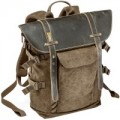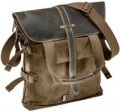Product type
—
Case. Provides minimal protection - mainly from dust, scratches and (sometimes) moisture. Well suited, for example, for carrying in hands or in a larger bag along with other things. The advantage of cases is compactness and light weight.
—
Case. It is made in the form of a pencil case. In the middle there are different sections, both for the photo-video camera itself and for different accessories, such as additional memory cards, a battery, a cloth for wiping the camera or its optics. It is made of fairly rigid materials.
— Bag. Classic bags are very versatile, well suited for any kind of travel, and usually have additional internal and external compartments. The thick and soft materials that most bags are made of provide some degree of shock protection even in officially ''non-shockproof'' models. They are usually equipped with a carrying handle and a shoulder strap.
—
Backpack. A special backpack with a compartment for a camera. As a rule, they are made of waterproof materials. They are very convenient for transportation, as they allow carrying on the shoulders. Quite capacious, in addition to photo and video equipment, they are designed for a variety of additional things.
—
Case. They have the highest level of protection compared to other types of camera bags. As a rule, they are made of metal,
...most often aluminum; when using textile or leather materials, a rigid frame (plastic, metal) is added to the design. The case can easily accommodate photo and video equipment and a set of lenses for it.
— Suitcase. Models of different shapes and types, including tech equipped with wheels. As a rule, they are designed to carry not only a photo-video camera and accessories, but also a fairly large number of additional things. This option is useful for tech who have to travel often.Compartments for photographic equipment
When choosing a camera bag, pay attention to the size of the camera compartment. This compartment is designed for storage and safe transportation of photographic equipment, and has dense and soft protective walls. The larger the size of the camera and the number of lenses / photo accessories used, the larger and more spacious the compartment for storing them should be.
Removable partitions
In semi-professional and professional models, the camera / lens compartment is equipped with
removable soft partitions. This allows you to adjust the interior space of the compartment to your liking.
External compartments
The outer compartment is designed to store small personal items/photo accessories and quickly access them. Usually, it is fastened with a zipper or Hook-and-loop.
Personal items compartment
Designed to store small
personal items and photo accessories.
Chest strap
Attachment in the form of a strap with a clasp that connects the main straps of the backpack at the level of the user's chest. When fastened, such a strap keeps the straps at the same distance from each other and does not allow them to “scatter”. This provides additional convenience in the distribution of weight, as well as a secure fit on the body: it is almost impossible to remove the backpack without unfastening the strap. To adjust to a specific user
, the chest strap is often made adjustable.
Tripod mount
Special belts are designed for
attaching a photo tripod or monopod to a bag / backpack, for their more convenient transportation.
Bottle pocket
Special
niche for a container with liquid. Can be used as an extra pocket.
Trolley sleeve
For convenient and safe transportation, most modern bag models are equipped with a special belt (or a special through compartment) on the back side, with which the bag is securely attached to the
retractable handle of a travel suitcase or luggage trolley.

